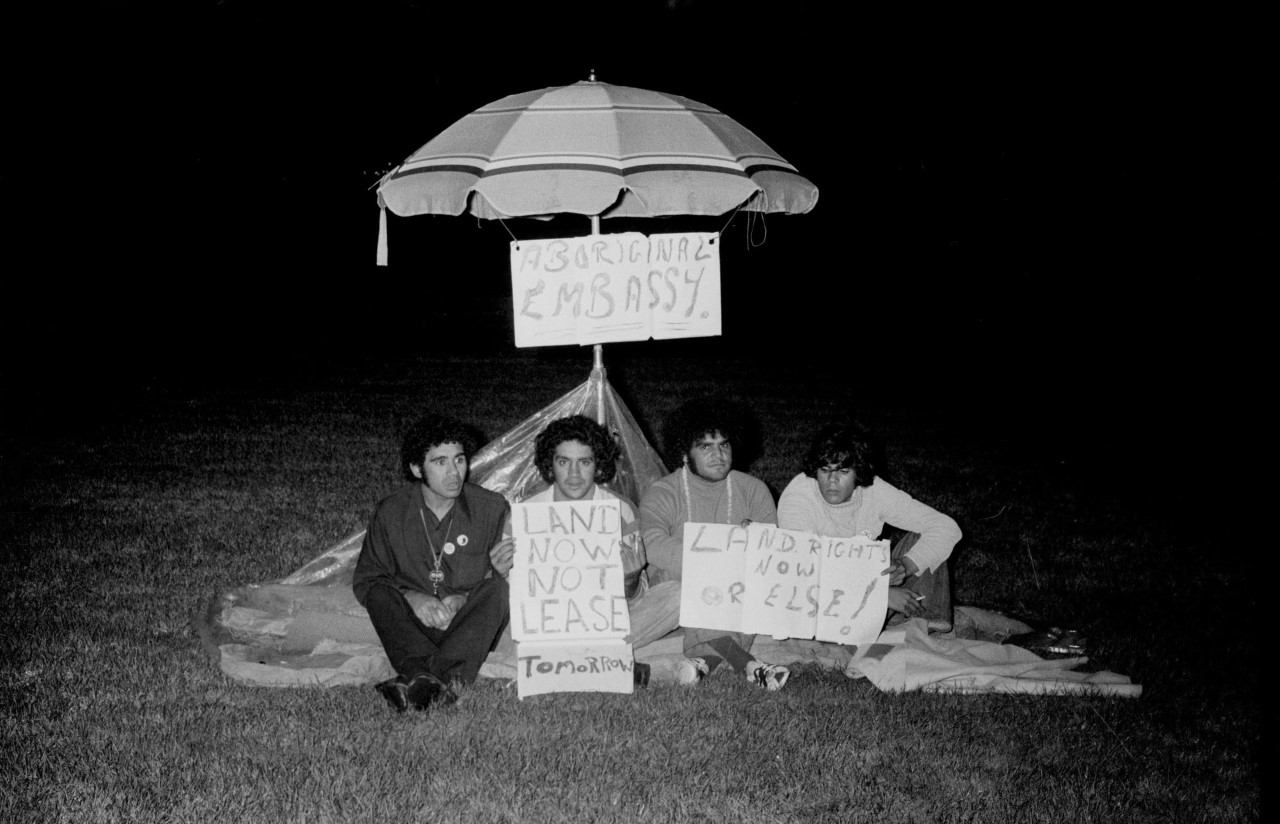Design Studio Research 1: Counterhegemonic Architecture

Fig 1. On 26 Jan, 1972, the national day of what is today known as Australia, the activists Michael Anderson, Tony Coorey, Billy Craigie, and Bertie Williams planted a beach umbrella by a tent on Capitol Hill in front of the Australian parliament in Canberra and declared it as the de facto representative diplomatic mission of the Indigenous local people to the (‘White’) people of Australia. (Noel Hazard, ‘ON 161/675: Tribune Negatives featuring the setting up of the Aboriginal Tent Embassy,’ 1972, photograph, BjX3KJWq0pPX3, Mitchell Library, AU State Library of NSW, http://collection.sl.nsw.gov.au/digital/BjX3KJWq0pPX3).
ARC3020Y F
Instructor(s): Lukas Pauer | lukas.pauer@daniels.utoronto.ca
Meeting Section: L0102
Tuesday, 9:00am - 1:00pm, 2:00pm - 6:00pm
This final year-long course sequence will support investigations on space and power in an effort to expose, challenge, and reconstitute the pervasive and ongoing reality of imperial-colonial expansion. This sequence will consist of a more directed seminar-style thesis prep research studio in the fall term and a more independent and self-directed thesis studio in the winter term that will culminate in an individual project. In the first term, we will collectively develop a better understanding of the role of built objects in current affairs to make sense of presently unfolding events that require urgency as well as to acquire tools and models for students to read how power has been written into the built environment. This will help us to understand how, in their efforts to play the ‘game’ of great powers, limitedly recognized or unrecognized self-governed polities have emulated the visual, material, and spatial language of hegemonic Euro-Western powers through a set of very particular imperial-colonial practices. It will also help us to understand how various political activists have already started to protest such practices with counterhegemonic ones. In the second term, based on the theoretical framework of the first, the students will work toward an individual project that serves the empowerment of marginalized, underrepresented, and vulnerable communities (eg of Indigenous, diasporic, and exiled people) as well as other victims of imperial-colonial violence.
There is a lack of general understanding of imperial-colonial violence as a pervasive and ongoing reality around the world. To not recognize the workings of this violence around us is a risk. Although recent scholarship alludes to a relationship between space and power as well as the various ways in which power has configured space, many people seeking to participate in the political life of their community still lack the vocabulary to describe how authority over people and land is manifested through seemingly minor or banal practices of the everyday. We have come up with diplomatic doctrines to respond to soft power. We have military doctrines to deal with hard power. However, policy-makers lack appropriate tools and models that aid the recognition of more hybrid kinds of non-verbal visual, material, and spatial interventions. These come above the line of what is commonly understood as diplomacy but below the line of warfare. Within this gray zone, recent practices have instrumentalized many different types of built objects such as memorials, power stations, lighthouses, and prescreening facilities to project power. Such objects capitalize on their ambiguity. They seem to be neither diplomatic nor military in function, which renders their instrumentalization plausibly deniable. A lack of understanding how any object may be instrumentalized for political purposes limits people's ability and responsibility to contribute to political decisions about the built environment.
At the beginning of the first term, the students will be able to choose from a range of case studies. Each of these cases will then be reconstructed and represented analytically and visually with historical or contemporary materials at predefined scales drawn by the students themselves. The acquired tools and models within the theoretical framework of the first term will serve as basis for the development of the students’ individual projects in the second term. Depending on individual interests, the students can either continue to work with the context of the case they selected in the first term or, alternatively, can look for their own context in conversation with the instructor and before the beginning of the second term. For example, a student might be more interested in an alternative context because they have unique knowledge of it or because it is more suitable for an approach they already have in mind. However, such an alternative context must both relate to the theoretical framework of this course sequence as well as allow the student to develop their own critical thinking. The more independent and self-directed format of the second term will provide the students with the necessary freedom to form their own approach to design in the development of an individual project positioned within the discipline of architecture and beyond.
This course is part of a major research project by the Vertical Geopolitics Lab, which will examine a large number of cases over the course of several terms.

